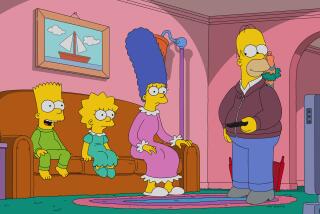Footnotes in Homer & Co. history
- Share via
In literature and in scholarly texts, the footnote is often overlooked -- regarded as an afterthought or an addendum to the real story. But here’s a hint for readers of the just-released “Planet Simpson: How a Cartoon Masterpiece Defined a Generation” (Da Capo Press): Running in small print through the 450 pages of author Chris Turner’s ponderings on the larger meaning of “The Simpsons” is a trove of show trivia and cultural allusions.
“They’re fun little asides,” says Turner, 31, a Calgary, Alberta-based journalist, “like hypertext links on the Web that provide more information.”
Turner’s footnotes riff on such topics as Homer’s lifelong dreams (a list that includes “eating the world’s largest hoagie” and “managing a beautiful country singer”); the inspiration for Krusty the Clown (a local TV clown in Portland, Ore., called Rusty Nails, whom a young Matt Groening found “incredibly disturbing”); and the number of times Maggie, the pacifier-chomping toddler has spoken (five by Turner’s count; her first word, “Daddy,” was voiced by Elizabeth Taylor).
Turner often segues into contextual musings, reprinting along the way a grunge lexicon from the New York Times (“Bloated, big bag of bloatation: drunk”) and a transcript of the Pets.com sock puppet’s appearance on “Good Morning America” in 2000.
In one aside, he rails against trimming syndicated “Simpsons” episodes to add commercials which, he writes, “amounts to gross mutilation, on par with removing every twentieth page from a copy of ‘Hamlet’ to insert a coupon for five cents off wax paper.”
After all, Turner argues earlier, “The Simpsons” is “in some respects a more powerful cultural force than rock & roll” -- more than just a footnote, you might say, in the annals of TV.
More to Read
Sign up for our Book Club newsletter
Get the latest news, events and more from the Los Angeles Times Book Club, and help us get L.A. reading and talking.
You may occasionally receive promotional content from the Los Angeles Times.






